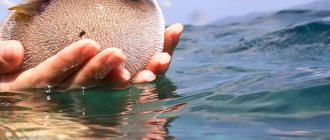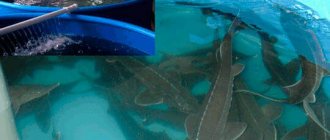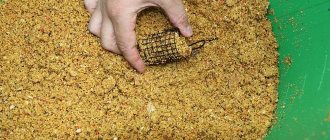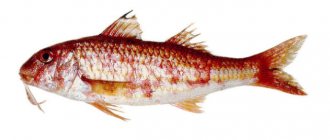What does a catfish look like?
Catfish come in different sizes - from 3 to 35 cm (depending on the species). These fish lead a bottom-dwelling lifestyle, preferring more nocturnal activity.
In addition to the absence of scales, catfish have a characteristic tuft of sensitive antennae near their mouths, which allow the fish to navigate in space. Other appearance features depend on the specific type of these aquarium inhabitants. Below we will look at several main varieties of catfish, which are most often used for stocking in an aquarium.
Ancistrus
Ancistrus or sticky catfish are one of the most common types of these fish. They belong to the type of chain-mailed catfish; the size of individuals rarely exceeds 15 cm. Beginners and experienced breeders of aquarium fish value them for the fact that they have a beneficial effect on the closed ecosystem of the aquarium. This is explained by the fact that they eat algal fouling, which often contaminates the walls of the tank and the existing decor.
Mature males are distinguished by the presence of a large number of tentacles - outgrowths on the head. They are absolutely not aggressive, so they can be combined with other types of fish. They are unpretentious in food: you can use sinking tablets with dry food (so the fish will quickly find them at the bottom).
Corridoras
This is a good solution for inexperienced breeders because these fish are very hardy. They are very energetic and are constantly searching for food at the bottom of the aquarium.
The size of individuals is no more than 12 cm. The color can be different: golden, olive, there are individuals with stripes and dark spots.
The optimal volume of the aquarium is at least 60 liters. Keep in mind that these fish have quite sensitive whiskers, so it is better to use sandy or other types of soil that do not have sharp edges.

Loricaria
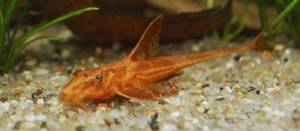
Loricarias are distinguished by an elongated body, the length of which does not exceed 12 cm. They are easy to care for, adapt well to different living conditions, and get along quite well with other aquarium fish. They prefer to hide, avoiding possible conflicts in every possible way. You should also select calm, non-aggressive fish for your aquarium.
Otocinclus
Otocinclus are one of the smallest catfish species (sizes rarely exceed 3 cm). They also act as cleaners, abundantly eating algae growths.
The color is very interesting: “zebra”, golden hue, as well as individuals with various spots. You can select a small aquarium for them (within 40 liters), but you need to be more careful in choosing neighbors, because fish that are too large and aggressive can harm them.
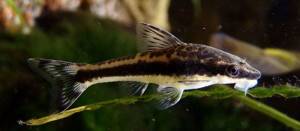
Pangasius

A very interesting species of catfish, which in appearance resembles a sea shark. If they are kept in natural habitats, they can grow up to one meter. In this regard, you need to choose aquariums that are large enough in volume, so this option is unlikely to be suitable for an ordinary city apartment.
Pterygoplichthus
This is another variety of large catfish species that can grow up to 50 cm in length (given a sufficient aquarium volume). They have a very beautiful leopard coloration and a fan-shaped fin raised up.
There should be at least 250 liters of water per individual. They are not aggressive, but still you should not place small fish with them, which could accidentally be harmed by this “giant”.
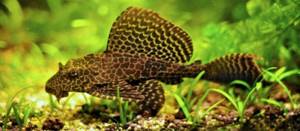
Glass catfish
Glass catfish have no pigmentation, so they are completely transparent. They are able to completely blend into their surroundings.
It is better to house them in large flocks in aquariums with a volume of 100 liters or more. It would be good if there were live plants inside. They are unpretentious in food and get along well with other aquarium inhabitants.
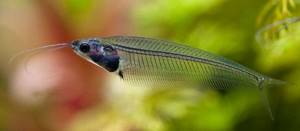
Torakatum
Torakatums, like other types of catfish, are distinguished by their peaceful nature, so they tolerate being in the vicinity of other aquarium fish well. But there is also a difference - thoracatums are much more active than other catfish, which most often prefer to hide.
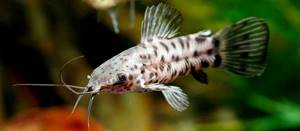
Dimensions – within 12 cm. The body is protected by hard plates. The color is usually dark brown. The fish actively search for leftover food at the bottom, so its decomposition is practically excluded.
There is one peculiarity, which is how these catfish reproduce. They build nests from bubbles, which is very uncharacteristic for catfish.
Causes of early death
In addition to death due to age, aquarium catfish can die for other reasons.
Diseases
In general, this is a fairly disease-resistant fish, but due to improper housing conditions, the catfish’s immunity may decrease, which provokes infection. For example, a catfish can get sick if the level of organic suspended matter in the water increases. Sometimes the slow-moving brocade catfish suffers from malnutrition, since its more nimble neighbors manage to eat its food. All these factors can lead to illness and subsequent death.
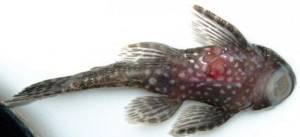
Incorrect treatment
An inexperienced aquarist begins to treat the catfish and thereby only aggravates the situation.
First of all, it’s worth figuring out whether the catfish needs treatment at all. For example, some species can suddenly change color and become covered in spots, and the frightened owner immediately begins intensive rehabilitation. In fact, this phenomenon is most often a reaction to stress and has nothing to do with illness. When the individual calms down, its previous color will return. Also, some breeders are alarmed when they see the pet's passivity. It is worth knowing that most individuals prefer to lead a nocturnal life, and in daylight such species become less active.
Remember that these fish cannot tolerate salt baths and preparations containing copper, although this is how other aquarium fish are usually treated. Therefore, avoid this type of treatment.
Thus, it is not recommended to treat catfish with Ectopur, Oodinopur and Mycopur - a concentration of copper sulfate of more than 0.25 mg/liter becomes fatal for catfish. As a last resort, use these products in very small dosages.
Illiterate breeding
An inexperienced owner has little knowledge of the breeding characteristics of catfish, so he does not specifically select suitable individuals, but takes the first pair he comes across for production. However, there are cases when a large male killed a more fragile female during the spawning period. Therefore, in order to avoid the early death of a female, it is recommended for breeding to select parents of the same size or a female whose mass is greater than the male.
Injuries
Some species, for example, Sturisoma, have an elongated long body that can fit into any hole. Often the curiosity of such a catfish leads it into the filter structure, where it dies. Such death is possible not only for catfish with a certain body shape, but also for young catfish of any variety.
Catfish can also be injured if kept in unsuitable water or in too small an aquarium. Thus, some species, for example, tarakatum or synodontis, have a tendency to jump out of the water under uncomfortable conditions.
If the owner notices the body lying on the floor in time, then it can be saved, but alas, the owner cannot be near the aquarium all the time. Even if you close the container with a glass lid, this will not protect your jumping pet from injury: he can break his nose on the glass, although in most cases this damage is not fatal.
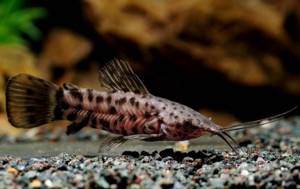
Aquarium catfish: maintenance, aquarium arrangement and care
Aquarium catfish are an unpretentious type of fish, but there are also some nuances regarding the choice of an aquarium and other points:

Reproduction
In the aquarium, catfish reproduce through spawning. It is necessary to prepare a spawning area of a certain volume (at least 10 liters). The water should be within 21 degrees. Strong aeration required.
A flat piece of plexiglass must be placed at the bottom of the spawning area. The female will lay eggs on it. You can also place a plant in the spawning area.
Differences between a female and a male
Sexual characteristics depend on the type of aquarium catfish. Most often, females are not so brightly colored and have a more rounded body shape. In the abdominal area, males have a pronounced genital tubercle and a round opening. Females do not have a tubercle, the opening is oval. Males tend to fight among themselves, especially in small aquariums. Females have a calmer behavior and do not share territory.
Spawning
Spawning of catfish lasts several hours. The males begin to chase the female. She takes milk into her mouth and smears it on the glass surface, and then glues several eggs to it. During the spawning period, the temperature is reduced to 22 degrees.
Caviar
The female lays more than 100-200 eggs. Afterwards it is removed, and the temperature is raised to 28 degrees. Incubation lasts approximately 3 days. After the fry of the catfish emerge, the temperature is reduced to 20-22 degrees and the babies are fed live food at least 4-5 times a day. The male must be removed after spawning.
What can you feed catfish in an aquarium?
Beginning fish breeders do not always know what aquarium catfish eat, so they assume that they are quite picky eaters. But this is absolutely not the case, so you won’t have much trouble feeding them.
The advantage is that they actively absorb food debris from the bottom, thereby cleaning it and preventing rotting processes. You can feed them sinking tablets with dry food, pieces of fish (for predatory varieties) and flakes, which are sold in special stores.

Reviews from aquarists
My seasoned platidora crawled out of his hiding place, I looked at this miracle and wondered how old he was? They gave it to me along with a hundred-liter aquarium, the owner was selling the aquarium and gave me this miracle as a bonus, with the words “take him, he’s left alone and won’t live long, he’s about six years old already, and he’s been living in a rotten jar for the last months, which there was no one to deal with.”
The aquarium really looked like it was in a deplorable state, it was all overgrown... Well, that’s how I took this beast... This was around 2003. After a while, the owner of the aquarium, having learned that the animal was alive, was very surprised... The ending of the story is this: it is 2015, the catfish is still alive and what is most surprising is that it is in excellent mobile condition (I specially examined it from all sides), this means he is 18 years old?
In addition to this catfish, I also have a girik, I bought it in February-March 2002, it is also vigorous, alive, chasing and building everyone in the aquarium.
Natalia
An ordinary Ancistrus has been living in my aquarium for seven years now... Daddy is wonderful.
Andrey
I have had acanthus in my aquarium since about 2003, there were three of them, recently I saw two, and at the moment there is only one left.
Ruslan
My friend has had a Pter since 1999, in a healthy 700 liter jar, about forty centimeters in size. In general, catfish live much longer than other aquatic animals purchased on the market. Why this is so, it’s better to find out from professionals, just as far as I know, the lifespan of fish in an aquarium is calculated at a couple of years, then they either die or get bored and pass into the hands of the next aquarist.
Maria
Catfish live for at least 10 to 15 years and often die from stupid, even sometimes ridiculous mistakes of their owners; neither a pro nor a student is immune from this.
Alexander
I have an agamix swimming, which I bought in 1997. In addition to my oldest catfish, I have another male ancitrus from 2000, from 15 to 17 centimeters long.
Novel
Where does this information come from? Even an ordinary anz lives for about 10 years, many even longer; large L catfish live for decades.
Ramon
...I assume that my acanthic catfish will even outlive me... even if I now stop drinking, smoking, eating... and switch to a low-carb diet... my monster is my luggage, which I will carry until my death...
Sergio
Exactly a year ago, I managed to exchange a pair of L181 catfish from an employee at work, asking the owner how old they were? She replied that about seven years!!!
Interesting: Description of the aquarium fish dolphin
I managed to breed catfish, the fry were born on May 9th.
Valentina
This is all nonsense, 7 years. I read in the literature about wild male 046, who is now 15 years old and still takes part in spawning. But we are talking about a small species of catfish. Just imagine how many years large acanthics and panacians live.
Albert
It’s good that there are 14 years old, otherwise I thought mine were quite old. But it turned out not old, but experienced.
Nikita
How are catfish distinguished by gender?
To successfully breed these fish, you need to know how to distinguish a male catfish from a female. There are a number of criteria to consider:
- Body dimensions. Females, oddly enough, are much larger than males.
- Growths on the face. Males, as a rule, always have antennae, while females do not.
- The color of males is brighter than that of females.
- You can pay attention to the area of the abdominal line - next to the anus. In males you can see a slightly protruding tubercle there, in females - a depressed pit.
Of course, the differences depend on the specific type of catfish, so it is better to check this information with specialists.
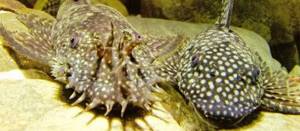
How long do catfish live: spawning age
At the age of 4-5 years, the named fish reaches sexual maturity. Catfish leave their holes and backwaters for about a month. During this period, males find their female - 3-4 contenders swim after one female. She chooses a mate for herself, and then the two of them drive away the rest of the gentlemen.
After this, the couple builds a nest for future offspring. Usually it is made in a primitive form in coastal vegetation. Here the female lays large eggs - the egg diameter is 2-3 mm. Their number varies. It all depends on the age of the female - a young female lays 10-15 thousand, and an older female lays 350-450 thousand eggs.
Until the young hatch, the catfish protects the nest from uninvited guests. It slaps the water with its huge tail, terrifying all the fish living nearby. At first, the baby is in the nest, feeding on silt and vegetation. And then the offspring scatter in all directions and begin to lead a predatory lifestyle.
How do catfish reproduce in an aquarium?
To stimulate the reproduction of these fish, you can lower or increase the temperature of the water in the aquarium. It is better to move the female and male into a separate tank, where all the necessary conditions can be created. Its volume should be at least 30 liters, there should be a sufficient number of snags, caves, etc. inside.
In almost all catfishes, the spawning period lasts up to 5 days. When the male has chosen a place, he cleans it so that the female will later lay eggs there, which he will fertilize. The “courtship period” takes up to one week, during which the male attracts the female’s attention in every possible way.
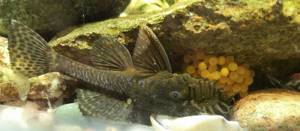
Types of aquarium catfish with photos, names and descriptions
The family of aquarium catfish is characterized by a wide variety of species, differing in their appearance, living conditions, care and nutrition requirements.
Catfish Ancistrus vulgaris or Ancistrus Claro - description, content, what to feed and reproduction
Ancistrus catfish are representatives of the most popular species of catfish and there are 30 varieties. One of the most popular is Ancistrus vulgaris or Ancistrus Claro; aquarists also call them: sticky catfish, cleaner catfish, sucker.
In an aquarium they grow up to 10 cm, but can reach up to 15 cm - this depends on the size of the aquarium and nutrition. A characteristic feature is the presence of a kind of suction cup located around the mouth.
Representatives of the species are also distinguished by many growths on the face and a specific dark coloring of the skin. They are not at all aggressive towards other types of ornamental fish, but can stick with their suction cups to species of aquarium fish that are too slow.
Ancistrus vulgaris prefers a warmer living temperature of +20-26° C. The recommended acidity of the aquatic environment is from 6-7.5 pH. Hardness up to 20° dH. Aquarium size for a couple of individuals from 50 liters. With proper maintenance, the lifespan is up to 6-8 years; it happens that they live up to 12 years.
In terms of nutrition, the common ancistrus has no special rules: dry and live food. The best tablets are those that sink to the bottom with plant or animal ingredients.
There is no need to create special conditions for the propagation of Ancistrus Claro. The male cleans the place in the aquarium that he has chosen as a spawning site. The female throws from 30–100 eggs with a diameter of 2–3 mm, bright orange and yellow eggs, which the male inseminates.
After the female lays eggs, it is better to deposit them, the male will take care of the eggs himself. He will remove dead eggs and fan the eggs with his fins to supply oxygen. If there are several females and one male in the aquarium, then the male will look after all the clutches in the aquarium.
If there are no males in the aquarium, but only a female, she can reproduce on her own - lay eggs and inseminate them, changing sex.
If necessary, a pair of catfish is placed in a container with a volume of 40 liters or more, and the owners will need to slightly stimulate reproduction by changing the living conditions.
Among Ancistrus there are also popular types: Ancistrus Veiled, Red, Diamond, Star-shaped, Black.
Catfish Ancistrus albino or golden - description, content, what to feed, reproduction
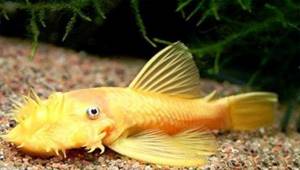
Representatives of this species have gained particular popularity among aquarium owners due to their specific appearance. Under optimal conditions, their length can range from 6 to 17 cm. The body of the albino catfish is long, flattened, and has a wide head. An important feature is the voluminous lips, which allow the catfish to remove food from hard surfaces. On the surface of the entire body and head there is a huge number of skin growths - a kind of sexual characteristic. Body color ranges from white to golden hue.
Like most representatives of its family, this species leads a bottom-dwelling lifestyle, preferring the dark time of day for activity. For optimal growth and reproduction, it is necessary to use at least 60 liters for a pair of individuals. The maximum temperature threshold ranges from +20-24° C. Acidity from 6.5-7.5 pH. Any hardness is suitable, since there is no sensitivity to it. To decorate an aquarium, experts recommend using plants with dense stems, since catfish clean the bottom and walls, breaking down fragile algae. Life expectancy is up to 5 years.
Ancistrus albino catfish are unpretentious in their diet; they readily eat dry, live and plant food. The main rule for the owner is to ensure that the food sinks to the bottom. Uneaten remains must be removed from the pond immediately to avoid overfeeding.
Under comfortable conditions, Ancistrus aureus themselves will begin to reproduce quite quickly. Placing sexually mature individuals in separate aquariums, additional stimulation of spawning is not required - it is enough to ensure optimal care of the aquatic environment.
Catfish Agamix star - description, content, what to feed, reproduction

The Agamix star catfish has a powerful body, reaching a length of up to 17 cm in the wild, and up to 10-12 cm in an aquarium. The head is flattened with three pairs of antennae on the lateral surfaces. The body tends to narrow as it moves towards the tail. The very tip of the tail is covered with bony plates, which give the catfish a ribbed appearance. Color of the body and fins: brown background with bright yellow spots.
The volume of the aquarium for representatives of this species of 4 individuals must be at least 100 liters; with smaller values, the growth of catfish slows down. Acidity from 6-7.5 pH, water hardness up to 25° dH and temperature from +25-30° C. Fish are very mobile, so it is better to decorate the aquarium with algae, underwater caves, and large, non-sharp pebbles. Lifespan in an aquarium is up to 10 years.
Feeding is carried out mainly in the evening, since this period is the peak of fish activity. They prefer live food with the addition of 1/5 of the plant diet. Catfish pick up all their food from the surface of the bottom, so large pebbles are the best base for an aquarium.
Breeding of star catfish begins after 2 years of age - it is during this period that individuals reach sexual maturity. Principles of stimulation for spawning:
- abundant feeding. The frequency of feeding is increased to 3 times a day;
- frequent replacement of water in the aquarium;
- reducing the hardness of the aquatic environment.
Sometimes additional drug stimulation is used in the form of injections of gonadotropin hormone into the fins. The ratio of males to females required for successful reproduction is 1:1.
Catfish Corydoras - description, maintenance, what to feed, reproduction

In zoological stores you can find a wide variety of Corydoras catfish. Each representative has a unique coloration, characteristic of individual 150 species. Here are some of them:
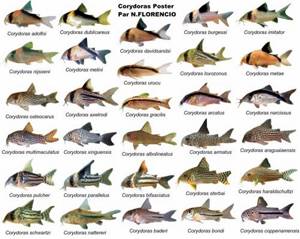
The body is represented by a narrow long layer with a convex back, covered with a shiny shell. The mouth is characterized by a low position, which facilitates eating food from the bottom. Three pairs of antennae located along the mouth opening help fish navigate in space and search for food.
Corydoras catfish, depending on the species, grow from 2-10 cm. The content in the aquarium also depends on the species, temperature range from + 18-30 ° C, acidity from 5.5-8 pH, hardness from 5-18 ° dH. For 8 individuals you need an aquarium of 60 liters. Life span is up to 6-10 years depending on the species. The soil at the bottom should not contain sharp edges or stones so that the catfish do not damage their antennae. Good water filtration and sufficient oxygen content are the key to successful growth and reproduction of aquarium fish of this species. Too high a temperature and cloudy water can slow down the growth of aquarium inhabitants.
Simik's diet should be varied, including dry food and special tablets with a high content of shrimp. Shrimp are a source of unsaturated fatty acids, which provide catfish with optimal growth, protection from diseases, and timely reproduction.
For breeding, you will need to select several large males and one female, and prepare an aquarium with a volume of more than 35 liters. Important components for successful spawning: lowering water temperature, increasing oxygen levels in the aquatic environment.
Catfish Hypancistrus Zebra or Zebra Pleco - description, content, what to feed, reproduction
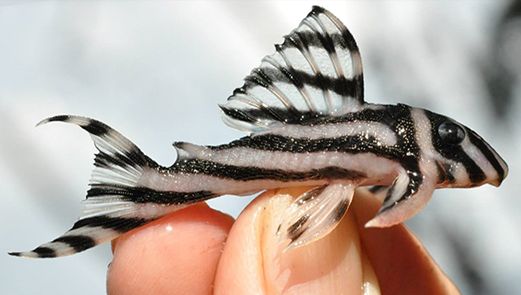
Catfish Hypancistrus Zebra or Zebra Pleco are small fish up to 7-10 cm long, the color of which has the appearance of original black and white stripes. A distinctive feature is their wide fins, which allow catfish to move quickly. Maintenance conditions: temperature from +26-30° C, acidity from 6 -7.5 pH, hardness up to 12° dH, high oxygen content and constant water filtration.
The most rational diet is a balance of natural and artificial food, which includes algae, plankton, and mixed feed. If these parameters are not observed, the fish quickly lose their external decor, become unstable to diseases, and become prone to allergic reactions.
It is quite simple to distinguish a male from a female catfish Hypancistrus Zebra. The male has a wider head and a thicker ray of the first pectoral fin, which is covered with hairs during spawning.
Reproduction occurs in the spring-autumn season. For spawning, a fish tank with a sufficient capacity of 35 liters is prepared. The main principles are spawning temperature +28-30° C and a balanced diet. Also the presence of a large number of shelters with minimal lighting.
Common diseases of catfish in the aquarium
Proper maintenance of catfish in the aquarium will prevent the development of various diseases in them. But in some cases, individuals still get sick, and it is important to know what diseases of aquarium catfish are and how to treat them.
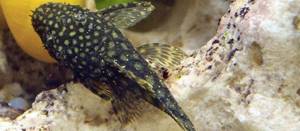
The most common:
- Semolina. This disease is caused by exposure to parasites. Numerous small white spots appear on the body of the fish. Semolina should be treated with a solution of potassium permanganate or formalin until the symptoms completely disappear.
- Oodiniosis. This disease can develop without specific symptoms, but with due attention, you can notice paleness of the body, as well as changes in behavior: excessive timidity, scratching against stones, etc. Treatment consists of using Bicillin-5, which has a pronounced bactericidal effect.
- Indigestion. Manifested by decreased activity and problems with appetite. The problem can be solved by normalizing the diet.
- Oxygen starvation. The problem is manifested by the frequent floating of catfish to the surface of the water.
Prevention consists of regularly replacing water (approximately 30% of the aquarium volume every week), as well as maintaining the correct conditions. During treatment, the sick individual should be isolated from other fish so that they do not become infected.

Catfish are not only one of the favorite aquarium fish of breeders, but also very useful inhabitants of aquariums. They act as cleaners, eating algae growths and food debris from the bottom. They are quite interesting to watch when they actively “explore” the bottom surface in search of food. Even an inexperienced aquarist will be able to choose the right type of catfish for himself, because they are unpretentious both in care and in food.
Our specialists provide professional services for custom aquarium creation, cleaning and maintenance. If you have any questions, please call us at our contact phone number.
Aquarium decoration - brocade pteriogoplicht
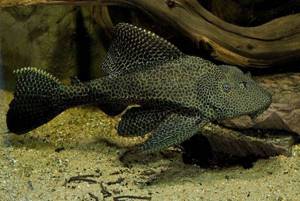
Another type of aquarium catfish that looks very impressive is the brocade pteriogoplicht. This fish has an unusual, interesting coloring; it resembles a pattern made up of individual spots. The color of the spots varies from light brown to completely black, and each spot is surrounded by a border of light color. The high dorsal fin of the brocade pterygoplicht is also colored in the same way. It is difficult to see such a beautiful fish and not buy it.
Typically, pet stores sell juveniles of these fish no larger than 4-6 cm in size, and they do not always warn novice aquarium enthusiasts about the real size of this fish. Under good conditions for keeping the aquarium catfish-pteryogoplychthus, it grows up to 30-35 cm, and in a small aquarium it can become a real problem.
The answer to the question of how long an aquarium catfish lives often depends on the conditions under which the fish is kept. Pteriogoplichts are considered one of the longest-livers in aquariums; they can live up to 18 years. Smaller ancistrus will also delight their owners for quite a long time - 8-10 years.
Hunting and feeding catfish
The question of how long catfish live is directly related to the food supply. The abundance of food allows the inhabitant of bottom pits to hunt nearby. He cannot spend much energy searching for food, because his body is not adapted to fast swimming and long pursuit of his prey.
Usually the catfish bursts into the flock suddenly and unexpectedly. Or he grabs the first fish he comes across that accidentally approaches him. Often during hunting, catfish use their wide tail, which stuns several fish at once.
However, it is always difficult for him to get fish. Therefore, the inhabitant of pits and backwaters prefers to hunt frogs. For him, this is a delicacy and easy prey. The catfish does not disdain mice that fall into the water, catches chicks of domestic and wild birds, and devours various mollusks and crayfish. Old and fat catfish easily attack adult waterfowl; they can even drag a dog to the bottom of a reservoir.
There is an opinion that seasoned catfish even hunt calves and pigs. But reliable facts have not yet been recorded, so these are more fiction than reality.
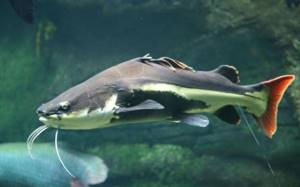
Most often, people do not allow soma to live to a ripe old age. For a fisherman, catching a big and old catfish is the ultimate dream. Fish fillet also plays an important role in catching it - it is juicy, fatty and not tough.
Based on all of the above, it becomes clear how long catfish live. On average 10-15 years, or even less. A rare specimen lives to a ripe old age.



